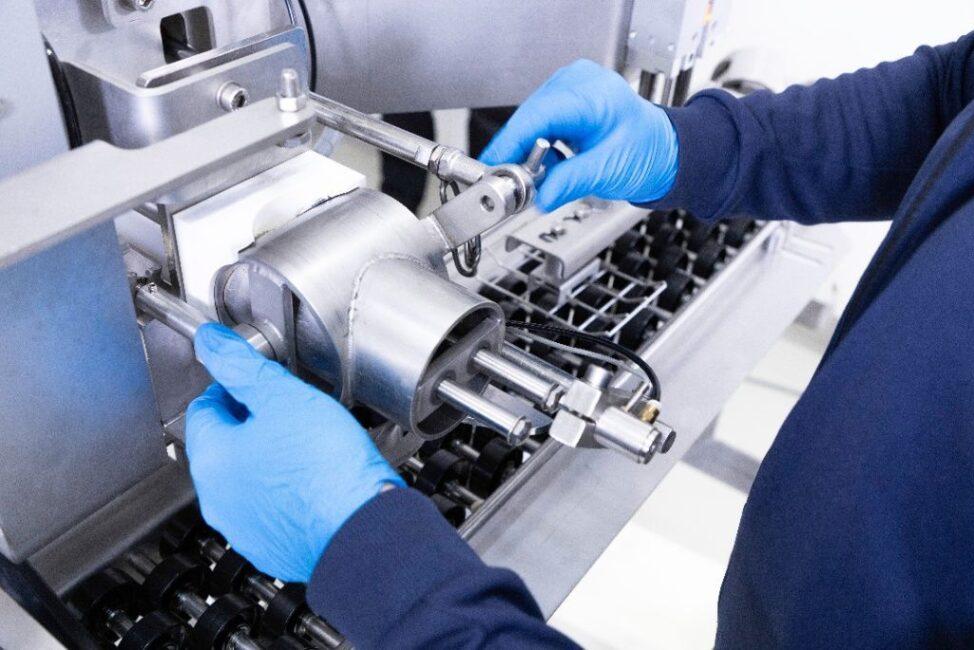
Choosing the Right Dosing Machine for Hygienic Ready Meal Processing
In This Article
-
Dosing machines ensure precise portioning, consistency, and hygiene in ready meal production, improving efficiency and compliance.
-
Gravimetric dosing measures ingredients by weight for high precision, while volumetric dosing measures by volume for faster processing.
-
Liquids and semi-liquids require anti-drip nozzles and pressurized systems to maintain accuracy and hygiene.
-
Solids and granular ingredients work best with auger-based or vibratory feeders to ensure even distribution.
-
Viscous and sticky products need piston-based or scraper-assisted dosing mechanisms to prevent blockages.
-
Choosing the right dosing machine requires balancing accuracy, speed, and cleaning efficiency for optimal performance.
-
Hygienic design is essential, with stainless steel construction, seamless surfaces, and easy-clean mechanisms to meet food safety regulations.
-
Kometos Finntray ensures precise, automated dosing of multi-component ready meals, accurately portioning pasta, rice, vegetables, and sauces while integrating seamlessly with tray packaging for efficient filling and sealing.
How Dosing Machines Keep Ready Meals Consistent and Safe
Dosing machines are specialized machines that dispense precise amounts of liquids, solids, semi-solids, and viscous products in industrial food production. Their primary function is to maintain consistency, accuracy, and efficiency across large production volumes, making them important for meal packaging and automated food processing lines.
Precision in dosing directly impacts the quality of ready meals. Accurate portioning ensures that each meal has the intended taste, texture, and nutritional value. Over- or under-portioning can lead to inconsistencies, affecting both consumer satisfaction and regulatory compliance.
Manufacturers also rely on dosing accuracy to control costs, as precise ingredient distribution minimizes waste and optimizes raw material usage. In addition, controlled dosing helps maintain nutritional consistency, ensuring that meals meet specific dietary requirements for caloric and nutrient content.
However, maintaining accuracy in hygienic food manufacturing presents several challenges. Dosing machines have to handle a wide range of ingredient consistencies, from free-flowing liquids to thick, sticky substances. This requires adaptable mechanisms that can maintain precision across different textures.
Hygiene is another critical factor—dosing machines have to be designed to prevent cross-contamination and microbial growth while meeting strict food safety standards. Regular cleaning and sanitation are necessary to comply with hygiene regulations, but this can be time-consuming if machines are not designed for easy maintenance.
Additionally, integrating dosing machines into automated production lines requires balancing speed and precision without compromising efficiency.
Gravimetric vs. Volumetric Dosing: Which One to Use?
Dosing machines ensure precise ingredient distribution in ready meal production. Two primary methods—gravimetric and volumetric dosing—offer different advantages depending on ingredient type, accuracy requirements, and production speed.
Gravimetric dosing measures ingredients by weight. Load cells and weighing sensors continuously monitor and adjust the process, ensuring high precision. This method is ideal for:
-
Liquids and sauces
-
Expensive ingredients that require strict control
-
Sensitive components where consistent weight matters
While gravimetric dosing delivers superior accuracy, it can slow down production because of constant weight calculations and feedback adjustments.
Volumetric dosing, on the other hand, dispenses ingredients by volume using pumps, augers, or piston-based mechanisms. It works best for:
-
Rice, pasta, and diced vegetables
-
Dry powders and bulk ingredients
-
High-speed production lines where slight weight variations are acceptable
Since volumetric dosing does not account for ingredient density changes, minor inconsistencies can occur. However, it enables faster processing, making it suitable for large-scale operations.
Choosing the right dosing method depends on production priorities. Use gravimetric dosing when weight precision is important. Opt for volumetric dosing for high-speed output with acceptable variations. Some modern machines integrate both methods, balancing speed and accuracy to meet diverse processing needs.
Matching Dosing Machines to Ingredient Types
Choosing the right dosing machine depends on the type of ingredient you are working with. Liquids, solids, and viscous products each have unique physical properties that affect how they should be dispensed. Matching the dosing mechanism to the ingredient ensures accuracy, prevents waste, and maintains product consistency.
Liquid and semi-liquid ingredients, such as soups, sauces, and oils, require controlled flow to avoid spills and portioning errors. Several dosing mechanisms handle these effectively:
-
Pump-based systems (e.g., peristaltic or diaphragm pumps) regulate fluid movement with minimal waste.
-
Nozzle and valve mechanisms provide precise dispensing and often include anti-drip features.
-
Pressurized dosing systems maintain consistent force for thick liquids that resist flow.
To prevent dosing inaccuracies, you have to consider factors like foaming, air bubble formation, and temperature fluctuations that alter viscosity. Using non-reactive materials, such as stainless steel, also helps prevent contamination.
Solid and granular ingredients, including diced vegetables, grains, and powders, require mechanical dosing to ensure even distribution. Key dosing mechanisms include:
-
Screw or auger-based systems for efficiently moving small granules and powders.
-
Vibratory feeders that use controlled vibrations to dispense dry ingredients evenly.
-
Rotary dosing systems for bulkier solids needing consistent portioning.
When dosing solids, ingredient separation and settling have to be controlled, especially in mixed components. Gentle handling prevents damage to fragile foods, while dust control measures reduce airborne particles when working with fine powders.
Viscous or sticky products, such as mashed potatoes, dough, and thick pastes, present additional challenges. Their high resistance to movement requires specialized dosing methods:
-
Piston-based dosing systems push out precise portions of thick materials.
-
Pressurized extrusion systems ensure a continuous, uniform flow.
-
Scraper-assisted nozzles minimize residue buildup and prevent clogging.
For these products, quick-clean features help maintain accuracy and prevent blockages. Temperature control is also important to keep viscosity stable during processing.
Some production lines benefit from multi-purpose dosing machines that handle both liquid and solid ingredients with modular adjustments. Testing different dosing methods ensures you choose the most effective system for your specific ingredients and production needs.
What Matters Most in a Dosing Machine: Accuracy, Speed, and Cleaning Efficiency
Selecting a dosing machine requires focusing on three key factors: accuracy, speed, and cleaning efficiency. Each of these influences production quality, cost-effectiveness, and compliance with food safety regulations. The right balance ensures precise portioning, smooth production flow, and minimal downtime for sanitation.
Accuracy is important to prevent both waste and regulatory issues. Over-portioning increases ingredient costs, while under-portioning can lead to quality inconsistencies or non-compliance.
Gravimetric dosing provides the highest precision by measuring ingredients by weight, making it ideal for applications where exact amounts are critical. Volumetric dosing, on the other hand, emphasizes efficiency and is better suited for high-speed bulk production where minor variations are acceptable. Several factors affect accuracy, including:
-
Ingredient consistency – Dry powders, liquids, and viscous mixtures behave differently, requiring tailored dosing mechanisms.
-
Machine calibration – Regular recalibration ensures the machine maintains its precision over time.
-
Automated feedback controls – Real-time adjustments correct dosing variations, improving reliability.
Speed plays an important role in maintaining production efficiency while preserving portion accuracy. High-speed operations require dosing machines that can process ingredients quickly without compromising precision. The type of dosing system impacts speed:
-
Volumetric dosing is typically faster since it measures by volume instead of weight.
-
Gravimetric dosing takes longer but ensures highly accurate portioning.
-
Automated dosing lines reduce human intervention, increasing overall efficiency.
To optimize speed, consider:
-
Ingredient flow characteristics – Some materials pour freely, while others require force to move through the system.
-
Machine responsiveness – Quick adjustments prevent bottlenecks and maintain steady production.
-
Integration with packaging lines – The dosing process has to align with filling, sealing, and labeling to avoid slowdowns.
Cleaning efficiency is critical for hygiene and regulatory compliance. Dosing machines have to be easy to clean to prevent cross-contamination and bacterial buildup, especially when processing allergenic or perishable ingredients. Key design features that improve cleaning efficiency include:
-
Smooth, seamless construction – Reduces residue buildup.
-
Tool-free disassembly options – Speeds up cleaning cycles.
-
Corrosion-resistant materials – Endure frequent chemical cleaning without degradation.
Other considerations include:
-
Cleaning frequency – Machines handling dairy or protein-based ingredients need more frequent sanitation.
-
Access to internal components – Ensures thorough cleaning without excessive downtime.
-
Compliance with food safety regulations – Machines have to meet industry hygiene standards such as HACCP.
The best dosing machines strike a balance between accuracy, speed, and hygiene. Prioritizing one at the expense of the others can lead to inefficiencies, production slowdowns, or compliance risks. A well-chosen machine delivers precise portioning, fast operation, and easy maintenance, ensuring smooth and cost-effective production.
How Kometos Finntray Keeps Dosing Fast Clean and Consistent
A dosing machine that lacks a balance between accuracy, speed, and hygiene can create more problems than it solves—leading to inefficiencies, production delays, or even compliance risks. The ideal system ensures precise portioning, rapid operation, and easy maintenance, all while integrating smoothly into automated workflows.
At Kometos, we understand that ready meal manufacturers need a dosing solution that adapts to diverse ingredients, maintains strict hygiene, and scales effortlessly with production demands. That’s why our Finntray dosing systems are designed to handle multi-component meals like pasta, rice, vegetables, and sauces with unmatched precision.
Built for high-speed, contamination-free processing, they seamlessly integrate into tray packaging lines, supporting various tray materials and sizes. Explore our full range of dosing solutions to see how Finntray can optimize your production.
FAQ
What is a dosing machine?
A dosing machine is equipment designed to measure and dispense precise amounts of materials, such as powders, liquids, or solids, into packaging or processing systems.
How does a dosing machine work?
Dosing machines operate by utilizing mechanisms like screw feeders, vibratory feeders, or pumps to control the flow of materials, ensuring accurate and consistent quantities are dispensed during manufacturing processes.
What are the types of dosing machines?
Common types include volumetric dosing machines, which dispense materials based on volume, and gravimetric dosing machines, which measure materials by weight for higher precision.
Why is dosing accuracy important in manufacturing?
Accurate dosing ensures product consistency, quality, and safety, reduces material waste, and maintains compliance with industry standards, which is crucial for consumer satisfaction and cost efficiency.
How to choose the right dosing machine?
Selecting the appropriate dosing machine depends on factors like the material’s characteristics (e.g., flowability, abrasiveness), required dosing accuracy, production speed, and compatibility with existing systems.




